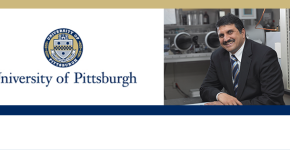 Accidents on the slopes and streets lead to broken bones each winter.
Accidents on the slopes and streets lead to broken bones each winter.
Prashant Kumta, professor of engineering at the University of Pittsburgh, details a new material that could help the body heal without the use of steel screws or plates.
Professor Kumta obtained his Bachelor of Technology (with Honors) in Metallurgical Engineering from the Indian Institute of Technology, Bombay, India in 1984. He then obtained his M.S. and Ph.D. degrees in Materials Science and Engineering from the University of Arizona in 1987 and 1990, respectively. He joined Carnegie Mellon University soon after graduation where he was instrumental in setting up the materials program in ceramic systems in the Department of Materials Science and Engineering, and was involved in spear heading the tissue engineering initiative which launched the bone tissue engineering center culminating in the creation of the Department of Biomedical Engineering in 2004. He joined the University of Pittsburgh in 2007 where he is currently the Edward R. Weidlein Chair Professor in the Swanson School of Engineering and the School of Dental Medicine with appointments in the Departments of Bioengineering, Chemical and Petroleum Engineering, Mechanical Engineering and Materials Science and Oral Biology. His main research interests are in the synthesis, structure and properties of nanostructured functional systems for electrochemical electronic, bone tissue engineering, biomineralization, stem cell engineering, and non-viral gene delivery applications. Professor Kumta is the recipient of the NSF Research Initiation Award (RIA), Fellow of the American Ceramic Society (ACerS), and the American Institute of Medical and Biological Engineers (AIMBE). He has edited/co-edited 9 books, given more than 120 invited presentations and is the author and co-author of more than 230 refereed publications with an average citations exceeding 7400 and an h-index of 44. He is currently the Editor in Chief of Materials Science and Engineering, B, Advanced Functional Solid-State Materials, an International Journal by Elsevier.
Biodegradable Parts for Fixing Complex Fractures

Avoiding the perils of winter is a healthy option. More than 100,000 snowboarding, skiing, ice skating and sledding injures will result in broken bones again this season, according to statistics from U.S. hospital emergency rooms nationwide. While some breaks can be repaired with a simple plaster cast, complicated fractures may require metal screws, pins, rods or plates and other fixation devices to hold the bone in place.
My team is leading the effort in developing novel biodegradable alloys of magnesium and iron, both essential elements of the human body. The novel alloys have mechanical properties and density matching natural bone. The degraded products can also be excreted from the body following healing while helping mend broken bones. Surgeons today resort to use of stainless steel, titanium or non-degradable polymers to mend complex traumatic injuries or combat related bone fractures. They elect to retain the material permanently in the patient’s body to avoid infections, related fracture, and other risks associated with complicated second removal surgeries causing major problems.
My team is circumventing the problem by designing 3D-printed degradable alloys that are printed to fit the patient using a proprietary binder ink cartridge. The computer sends directions to mix the glue droplets with the magnesium and iron based alloy powders to build the patient specific customized construct layer by layer.
We are also working with a novel formulation of a bioresorbable calcium phosphate putty that can be injected or 3-D printed to fill the bone void spaces between the fractured bones. The 3-D printed biodegradable magnesium or iron alloy plate or screw will then hold the resorbable filler in place.
Thus rather than implanting a screw or plate, doctors will be able to give the body’s own regenerative ability to more effectively heal itself.

